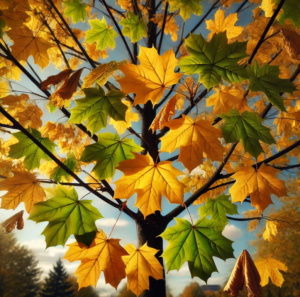Notes
pigment – 色素 – 植物や動物などの組織に含まれる、色を持つ物質。
chlorophyll -クロロフィル – 植物が光合成を行うために必要な緑色の色素。
photosynthesis – 光合成 – 植物が光のエネルギーを使って、二酸化炭素と水から酸素と栄養分を作り出す過程。
Carotenoids – カロテノイド – 黄色やオレンジ色をした色素で、植物の葉や果実に含まれている。
conserve – 保存する。
*********************************************
In autumn, leaves change color because of changes in weather and daylight. Trees absorb sunlight through their leaves, which contain a pigment called chlorophyll. Chlorophyll gives leaves their green color and helps trees produce food through photosynthesis.
As autumn arrives, days become shorter, and the temperature drops. Trees start to prepare for winter by slowing down their food production. This means they stop making as much chlorophyll, and the green color fades away. As the chlorophyll disappears, other pigments in the leaves, like carotenoids, become visible. Carotenoids give leaves their yellow and orange shades.
This process helps trees conserve energy and water during the colder months when sunlight and water are limited. Eventually, the leaves fall off, allowing the tree to survive through winter and grow new leaves in spring.
*********************************************
